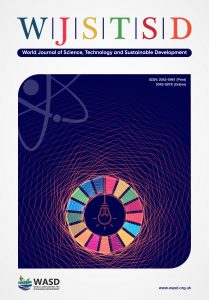Corruption levels of countries and progress on ensuring environmental sustainability, Prof. Beverlee Anderson
Prof. Beverlee B. Anderson
Department of Marketing
California State University, San Marcos, California
USA
Email: banderso@csusm.edu
DOI: 10.1108/WJSTSD-02-2015-0007
Purpose: The purpose of this paper is to explore the relationships of selected measures of environmental sustainability and the level of corruption within countries.
Design/methodology/approach: The design uses secondary data from Transparency International on perception of corruption within countries. The World Economic Forum’s (WEF’s) environmental sustainability assessment is one measure of environmental sustainability used in the study. World Bank data on CPIA Policies and institutes for environmental sustainability that foster and protect sustainable use of natural resources and manage pollution and its data on the Millennium Development Goal (MDG) target of the percent of population with access to improved drinking water were two specific measures used to indicate environmental sustainability. A series of statistical tests were used to examine the relationships among perceptions of corruption and a country’s policies and reported improvements in environmental sustainability.
Findings: The findings are mixed; the level of corruption does not appear to always be negatively associated with environmental sustainability as was expected.
Research limitations/implications: The research is limited by the availability of data from reliable sources over a period of time. The corruption data, while the best available, are based on opinions and perceptions. Only selected aspects of a country’s environmental sustainability were examined; these included the Environmental Sustainability Index, evaluations of selected countries; policies and institutions; and the improvement in the percent of the population with access to safe drinking water.
Social implications: In general, the less corruption, the better the record of environmental sustainability. However, corruption may not be a negative influence on specific selected aspects of environmental sustainability as would be anticipated.
Originality/value: This study examines selected aspects of the potential relationships between corruption and environmental sustainability measures. There is little, if any, research into this relationship.
Keywords: Sustainability; Sustainable development; Sustainable environment; UN Millennium Development Goals.
Citation: Anderson, B.B. (2015), "Corruption levels of countries and progress on ensuring environmental sustainability", World Journal of Science, Technology and Sustainable Development, Vol. 12 No. 2, pp. 90-99. https://doi.org/10.1108/WJSTSD-02-2015-0007

